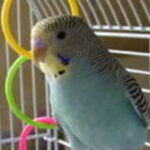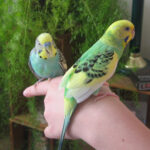Are you one those who’d love to have a few colorful, playful parakeets (also called budgies) in the house, but can’t stand the sad sight of them sitting in a cage their whole lives? If so, learning how to finger train a parakeet is the solution. Once finger trained, your parakeet can come out of the cage to fly around the house, survey his terratory from the chandelier, or ride around on your shoulder (and chew your hair). This also makes a parakeet more like a “real” pet you can interact with, instead of something like a fish in a bowl.
As someone who’s had parakeets since childhood, I’ve hand quite a bit of hands-on experience with finger training them. Here are some guidelines for how to finger train a parakeet based on what’s worked for me and my birds.
Parakeets, like any species of bird, have their own unqiue needs when it comes to training. Some larger birds, such as parrots, are so fearless around people that they actually attack, while small species, like finches, are too fearful and flighty to accept much training. Parakeets are somewhere in the middle. Parakeets generally don’t attack or bite, but they’re often a little timid around people at first.
To finger train a parakeet, the first step is to gain the bird’s trust. If you’ve had your parakeet for a few months or longer already, he’s probably already used to you having your hands in the cage from time to time, so you’re standing nearby won’t bother him.
If the parakeet is brand new in your home, though, he’ll probably be a little skittish around you. In that case, avoid the cage for a few days while the bird gets settled in. After this, you can slowly aproach the cage and, when the bird starts to look nervous, stop at that point and gently talk to him for a few minutes. Do this a few times a day for a week or so and eventually, you’ll be able to come right up to the cage without startling the parakeet.
The next step is to get the parakeet used to the idea of being near your hands. Slowly open the cage and put your hand just inside the door, leaving it there for the bird to look at. Remember to gently talk to the bird as you do this. Repeat this a few times a day, each day bringing your hand closer and closer to your parakeet. Just watch the parakeet for signs of nervousness and stop whenever he starts to react fearfully. Work slowly. One sudden movement that gives the parakeet a bad scare can set your work back a week.
At some point, once your hand starts coming within a few inches, the bird will probably think you’re going to try to grab him and may suddenly start or fly away. Don’t worry about this. When he realizes you don’t want to catch him, he’ll calm down again.
When you’re able to get your hand right next to the parakeet, stick your index finger out to form a perch and gently place your finger against the lower part of the bird’s belly, just above his feet. Now, your parakeet will most likely look at you like you’re crazy. At first, most have no idea why some nutso human is nudging their belly. So, you’ll probably have to give your bird a hint. To do this, with your finger, apply very gentle even, upward pressure to the bird’s belly. You don’t want to push so hard he falls of the perch, but you do want to make him lose his balance a little. If he stumbles, he’ll instinctivly step forward to balance himself and the first thing available to step on will be your finger. It may take a few times of doing this, but eventually, your bird will happily stand on your finger.
Once your parakeet is comfortable on your finger, you’ll need to get him used to the idea of leaving the cage. One way to do this is by taking the parakeet on your finger and slowly withdrawing your hand back out the door again. The difficulty of actually getting the bird out the door varies from bird to bird. Some will bolt for the door as soon as they realize you won’t stop them; others will peacefully hop off your finger and back to a perch every time you get them near the door. If your parakeet seems reluctant to step outside, leave the cage door open for a while for a few days and the parakeet will most likely venture out on his own for at least a few minutes. Some birds just seem to feel that riding out on your hand is being “forced” and prefer to come out for the first time on their own terms.
After leaving the cage, your parakeet may fly off your finger and land on the bars of the cage, with seemingly no desire to go anywhere. If he keeps wanting back in the cage, try putting a stick of millet seed on the cage that’s only reachable while the bird’s outside. Few parakeets can resist millet and, while he’s sitting there munching, he’ll realize being “on the outside” isn’t really all that scary. Fortunately, this fearful period usually lasts only a few weeks. Eventually, the parakeet realizes what fun it is to fly around and explore. Some birds will stay out all day, while others want to go back after only and hour or so.
When you know how to finger train a parakeet, you can not only give your bird a more interesting life, you can have more fun interacting with him. Just have patience and be gentle and your parakeet will soon be finger trained.






